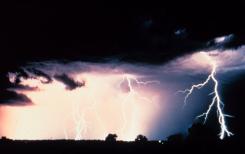Lightning
One of the most spectacular displays of nature is lightning. Lightning is a massive discharge of electricity in response to a charge differential. The actual cause of lightning is not completely understood, though its propagation is quite well established. What we do know is that lightning occurs in clouds that are located above the freezing level and are precipitating. For lightning to occur, there must be a charge differential within a thunderstorm, or between a thunderstorm and the ground or another cloud. Studies have shown that a charge transfer occurs across thin films of water present on ice crystals and hailstones when they collide. Solids (e.g. ice, hailstones, graupel) are often coated with an extremely thin film of liquid-water a few molecules thick. The molecules are weakly bound to the solid portion beneath even at temperatures below freezing. When an ice crystal and hailstone collide in a cloud, some of the liquid-water molecules from the hailstone move to the ice. During this process there is a net transfer of positive charges from the hailstone to the ice and negative charges from the ice crystal to the hailstone. The heavier hailstones fall to the base of the cloud while the lighter ice crystals are suspended at higher altitudes creating the charge separation with mostly negative charges near the base and positive charges aloft. The accumulation of negative charges at the base of the cloud repel the negative charges on objects at the Earth's surface. Thus below the thunderstorm the Earth's surface attains a net positive charge. When the difference in charge is great enough lighting is discharged. The whole process takes a mere fraction of a second and appears to occur from the cloud toward the ground. Actually, the discharge takes place in a series of steps. First, a stream of electrons flow toward the ground in a series of discrete steps called a step-leader that creates a branching ionized channel. When the stepped leader comes within 100 meters of the ground a positively charged return stroke surges upward. An ionized channel a few centimeters in diameter connects the Earth to the cloud along which electrons flow and illuminate the channel. After the initial electrical discharge, dart leaders of electrons follow the same conducting paths to the ground. Return strokes again meet the dart leaders and the path is illuminated once again. The entire lightning sequence takes less than two tenths of a second and can emit 100 million volts. The massive discharge rapidly heats the air sending a shockwave through the atmosphere we hear as thunder. Figure 8.27 Formation of cloud-toground lightning. (Source: Michael Ritter)
|
 Figure 8.26 Cloud - to -ground lightning
Figure 8.26 Cloud - to -ground lightning